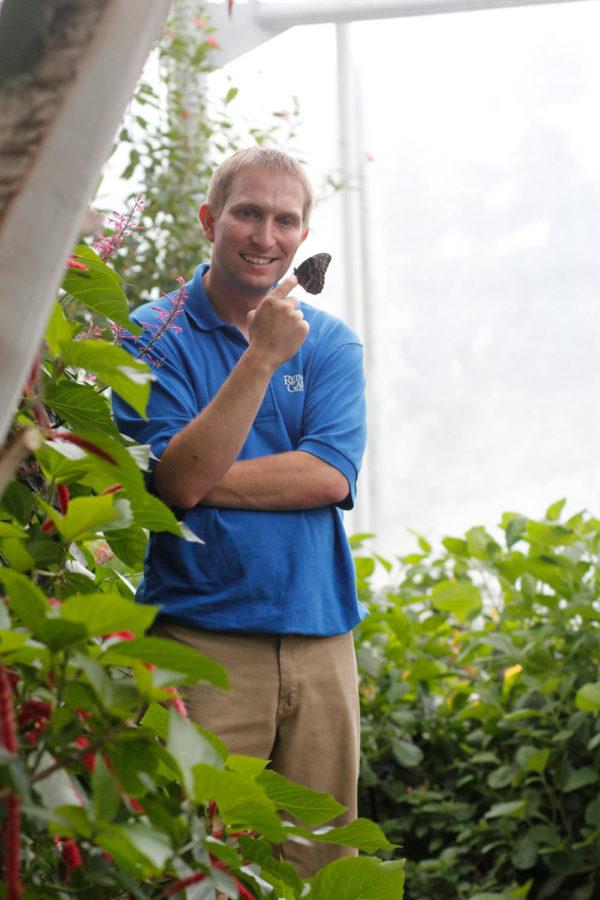One-on-One with Nathan Brockman
Reiman Gardens butterfly wing curator Nathan Brockman poses with a butterfly inside the butterfly wing of Reiman Gardens.
July 2, 2014
Nathan Brockman is the curator of the butterfly wing of Reiman Gardens. Brockman is a graduate of Iowa State who loves the variety of butterflies he gets to work with as well as the different research teams that refer to the butterfly wing he gets to use.
What got you involved with working with the butterflies at Reiman Gardens?
I got my degree in entomology here at Iowa State and I’ve always been interested in and excited with working with insects. I came to Iowa State because I wanted to work with insects in some way and when I was at Iowa State I started with the insect zoo on campus. Then about the time I was graduating, this position came online and I came over here initially as the “butterfly rearing specialist” and after about a year we had some staff stages where we went from having two entomologists to one and I became the curator of the butterfly wing.
Take us through a day of what you do.
There’s a lot of activities that happen out here regularly, and I do some of the day-to-day things with the butterflies, and I have some students and another entomologist that is full-time that helps do that as well. Yes, there’s some days I come in and release the butterflies and take care of some things in the wing. But as the curator, I do a lot of the paperwork side of things, reports for the [U.S. Department of Agriculture], putting together a lot of the educational material that has to do with the butterfly wing. We have a new app for the wing, so a lot of the content that goes towards that, I’m working to put that together … I take more of the administrative stuff these days, but I still get down [to the wing] so that I can release them.
What is the main topic of study with butterflies?
There’s a variety of things that are happening out here. This unit supports the butterfly wing. We’re an educational institution making a nice place for visitors to the garden to come and visit them.
We do research in here and we do a variety of things. A lot of the things we have done are capturing things, post plant preference and just this last winter we had a visiting scholar in here doing wind tunnel work so we had a wind tunnel sent up with butterflies flying through it and they were looking at different parts of the butterfly’s flight, so we also help other units do research because we have all these butterflies.
Right now, we’re gearing up and we’re going to be doing some work on captive rearing of native species. Some of our native species here in Iowa, they’re really in peril here in the state and the only way that we can increase the number in the state is to have some sort of captive rearing program put together where we can raise them and build up their numbers so we can release them into appropriate areas in the state and build those populations again.
Have you ever had any butterflies escape?
We have a lot of safeguards in place to ensure that the butterflies don’t get out of the space. With all our best efforts, sometimes a butterfly gets away and into the building complex itself, but we take every precaution possible to catch and maintain.
What’s the most memorable thing that has happened here?
We often get asked what’s the rarest butterfly that we have, and rare is a really relative term because a butterfly in one country could be considered rare there, but if you go to another country it could be very common. So, it’s hard to say what a rare butterfly may be, but we did have one case where we actually received a gynandromorph and what that is is a genetic term. A gynandromorph is an individual that is half male and half female on the same butterfly.
So we actually received a butterfly, a leopard lacewing, that was a gynandromorph. Half of it was the female form and half of it was the male form. I had just got back from a conference and was just wandering through the butterfly wing and checking on conditions and was chatting with a group of students and all of a sudden there was this gynandromorph and I started freaking out because we’d never received this before.
We’ve still only received that one that we know of and with some species of butterfly it’s hard to tell because male and female look the same, but with a leopard lacewing it’s extremely different, so I’m really excited that we got one and we got a ton of pictures of it.







